
The
star of the piece though, is Miranda.
Played with panache by Toyah Willcox,
that wild child of the punk era...
| "Full of magic and
surprises...the most truly
spectacular British film in
years." -- The Times The
Tempest, the last of William
Shakespeare's great plays, was
adapted for the screen for the
first time by Derek Jarman in
1979.
Shot
on location at the ancient and
ghostly Stoneleigh Abbey, The
Tempest tells the story of
Prospero the magician, who lives
with his nubile daughter on an
enchanted island and punishes his
enemies when they are shipwrecked
there. It's a study of sexual and
political powere in the guise of
a fairy tale.
Jarman
presents Shakespeare's intricate
comedy of magic and revenge in a
form that is at once faithful to
the spirit of the play and an
original and dazzling spectacle
mixing Hollywood pastiche, high
camp, and gothic horror. His film
recalls the innocent
homoeroticism of Pasolini's
versions of classics, while its
lush sense of décor and color is
worthy of Minnelli.
The
film's master stroke is the
finale, a wedding feast designed
and choreographed as as full
scale production number, with the
veteran black comedy musical star
Elisabeth Welch wafting her way
through a chorus of hunky sailors
as she belts out "Stormy
Weather." It's one of the
great scenes in British
cinema.
|
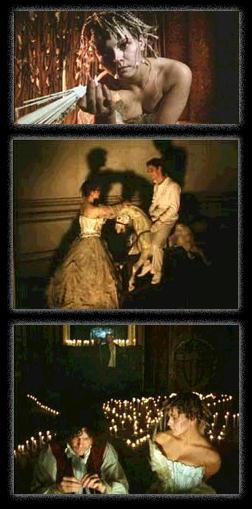 |
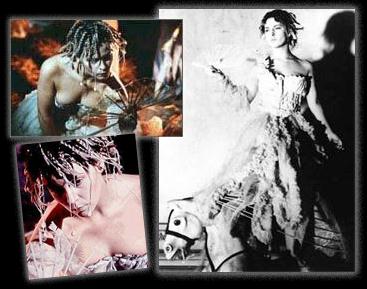 |
Toyah
plays Miranda, the daughter of
Prospero, in her 4th film role,
and the 2nd to be directed by
Derek Jarman "The
star of the piece though, is
Miranda. Played with panache by
Toyah Willcox, that wild child of
the punk era, she wanders the
halls of Prospero's fortress,
outrageously costumed in a
stunning combination of period
and punk tatters as she draws
strangers into her home while
longing for freedom. A far cry
from the chaste and maidenly girl
of Shakespeare's original, this
Miranda is a feisty, buxom,
sexual young woman who, instead
of Prospero, herself appears to
be the magician at the heart of
the tempest."
--
Channel 4 Films.
|
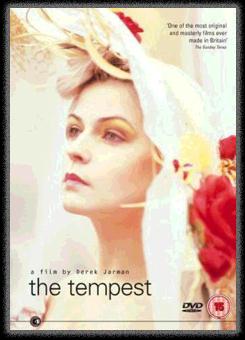 T IS
FOR...THE TEMPEST.
"As you from crimes would
pardoned be/Let your indulgence
set me free." Shakespeare's
masterpiece has held an almost
mystical fascination for British
film-makers: Michael Powell long
harboured a dream to make it with
James Mason; Peter Greenaway cast
John Gielgud in his massive,
mannered alchemical 1991 reading.
Jarman had himself broached the
subject with Gielgud in the 70s,
but finally cast poet/performer
Heathcote Williams as the rather
bedraggled, frock-coated vengeful
exile on his magic isle, and
Toyah Wilcox as his ethereal
daughter Miranda, which prompted
more than one to call this a Punk
reading of the play. T IS
FOR...THE TEMPEST.
"As you from crimes would
pardoned be/Let your indulgence
set me free." Shakespeare's
masterpiece has held an almost
mystical fascination for British
film-makers: Michael Powell long
harboured a dream to make it with
James Mason; Peter Greenaway cast
John Gielgud in his massive,
mannered alchemical 1991 reading.
Jarman had himself broached the
subject with Gielgud in the 70s,
but finally cast poet/performer
Heathcote Williams as the rather
bedraggled, frock-coated vengeful
exile on his magic isle, and
Toyah Wilcox as his ethereal
daughter Miranda, which prompted
more than one to call this a Punk
reading of the play. The film
was shot entirely on location at
Stoneleigh Abbey (where the play
was once performed for Elizabeth,
the Winter Queen, in 1612) for a
mere £150,000. "The endless
corridors and lots of
rooms...suggested servants,
romantic scholars with opium
pipes, young girls with dresses
spun from gossamer and frosted
with shells and feathers. By the
time filming was commenced, on
February 14 (1979), we were
living in another world. The
cameras began to turn with the
house in darkness, its shutters
closed against the blizzards
outside."
Unlike
Greenaway's pyrotechnic but
ultimately faithful
interpretation, Jarman's Tempest
opts for a dream format, allowing
the director to dissect the text
at will: "I cut away the
dead wood (particularly the
comedy) so that the great
speeches were concertinaed. Then
the play was rearranged and
opened up: the theatrical magic
had to be replaced." What it
is replaced with is a genuine
magic.
In
the same way Greenaway makes the
island central to his concept, so
Jarman makes the house a
character in his, gathering
shadows and occult symbolism to
often quite startling effect, so
that for much of its run his film
is a surreal, claustrophobic and
almost frightening confection.
But brilliantly, the finale
overthrows the dark horror and
unease in favour of the
transcendent magic of which
Greenaway falls short, topped off
by the arrival of the sublime
veteran jazz singer Elizabeth
Welch to croon 'Stormy Weather'
and the little sailor boys
dancing.
"The
Tempest obsesses me. I would like
to make it again, would be happy
to make it three times."
Taken
from: 'Somewhere Over The
Rainbow': An A to Z of Derek
Jarman, by Gerald Houghton
(1993).
|
 Toyah
on... The Tempest,
and Miranda Toyah
on... The Tempest,
and Miranda "Filming
The Tempest was an
absolute joy. Derek had evolved
from an experimaental film-maker
into a serious director; everyone
looked upon him as a god. He was
always the driving force. He was
always an inspiration to be with,
never lacking in energy and never
lacking in ideas, always totally
focused. And as he promised,
before I shot any scene, he'd sit
with me and go through the
dialogue word by word. He'd give
me Shakespeare's intended meaning
but he'd also give me the freedom
- and the confidence - to
reinterpret it.
My
performance energy had to be much
more contained to play Miranda;
even though she is a wild child,
she is nothing like Mad in Jubilee.
This is a woman born of royalty,
but who has never tasted royalty.
She has no concept of male or
female, no concept of sex, but at
the same time she is hugely
voluptuous, sensual and desperate
to experience some form of
touch. But there is no one
around to touch. Then a Prince is
shipwrecked on the shore. And
very quickly and very
beautifully, Miranda goes from
being a bug to becoming a
butterfly. It was virtually
impossible not to play Miranda as
a magical creature. The
surroundings of Stoneleigh Abbey
exuded a strange energy; you felt
surrounded by spirits of the
past. And Derek had turned it
into an even more magical place,
full of colour, beauty and
diversity."
Taken
from: 'Living Out Loud', by Toyah
Willcox (2000).
|
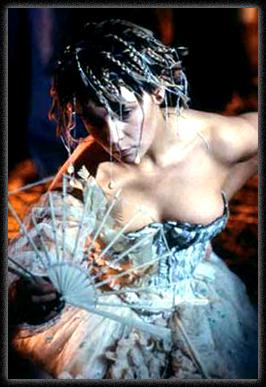 The Tempest by
Julian Upton The Tempest by
Julian Upton Touching
the outer parameters of
mainstream cinema, The Tempest
(1979) followed Sebastiane (1976)
and Jubilee (1978) to form the
last in a trio of films that
established Derek Jarman as the
most innovative British director
of the late seventies. The
Tempest sees Jarman deliberately
subvert the narrative and visual
conventions of ‘the period
film’ and guide
Shakespeare’s echoey text
through an eerie carnival of camp
and claustrophobia, punctuating
the proceedings with unhinged
turns from vaguely familiar faces
(Jack Birkett, Toyah Willcox and
Christopher Biggins, no less!)
And by exposing the play –
albeit subtly – to the
homoeroticism of Sebastiane and
the brutal frankness of Jubilee,
Jarman creates an adaptation that
belongs to him much more than it
does to the Bard. The emphasis on
wild anachronisms – always
bold and inventive - prefigures
similar, more commercial efforts
by Baz Lurhmann, Kenneth Branagh
et al by nearly two decades. And
although the miniscule budget
shows, it does not hamper the
enterprise – Jarman seems to
be the only British director of
the time prepared to paint with
darkness and shadow as much as
with light.
The
Tempest’s outrageous finale
is its most talked about and most
artistically
‘troubling’ scene. You
can judge its success for
yourself, but it clearly presents
the most striking evidence that
the director was tiring of
obeying the rules of classical
cinema. It is significant, then,
that The Tempest was
Jarman’s last
theatrically-released feature for
over six years.
Jarman
resumed painting, designing and
creating personal work through
alternative media. By the time he
returned to a more sustained
programme of film-making in the
mid-eighties, he was suffering
from the onset of AIDS.
Ironically, it was the knowledge
of this condition resulted in a
newly energised body of work, and
from this point on Jarman
eschewed the dramatic consistency
– albeit wildly eclectic
– of his first three films.
The Last of England (1987), then,
is perhaps the most ambitious
expression of the director’s
later obsessions and
preoccupations. Refusing to
reward the viewer on a narrative
level, The Last of England serves
instead as a fractured tapestry
of personal themes and downbeat
polemic. By now, Jarman was a
celebrated auteur - Sebastiane,
Jubilee and The Tempest had all
received respectful airings on
British television – and he
was in a position to indulge
himself as ‘an experimenter
of form’. Consequently, The
Last of England unleashes a
jarring kaleidoscope of – in
turns – striking and
soporific images: personal
moments captured on bold Super 8;
discoloured montages of a nation
in decline; slow, sustained
passages of gay lovemaking.
Whether this is engaging depends
on your opinion of Jarman as a
cultural force; certainly, it
forms a powerful personal
expression, and is a clearly a
visual descendant of the earlier
works. But where The Tempest can
be enjoyed, The Last of England
must be endured. Ultimately,
Jarman didn’t want us to
have it easy.
|
Heathcote
Williams as Prospero, Right
Duke of Milan
Toyah Willcox as
Miranda, his daughter
Richard Warwick
as Antonio, his brother
Peter Bull as
Alonso, the King of Naples
David Meyer as
Ferdinand, his son
Neil Cunningham
as Sebastian, his brother
Ken Campbell as
Gonzalo, an honest councillor
Karl Johnson as
Ariel, an airy spirit
Jack Birkett as
Caliban, a savage and deformed
slave
Christopher Biggins
as Stephano, a drunken mariner
Peter Turner as
Trinculo, his friend
Elisabeth Welch
as A Goddess |
Directed by Derek Jarman
Adapted for the screen
by Jarman, from William
Shakespeare's play
Produced by Don Boyd,
Guy Ford & Mordecai Schreiber
Cinematography by Peter
Middleton
Production Design by
Yolanda Sonnabend
Art Direction by Ian
Whittaker
Sound Editor Sarah
Vickers
Edited by Lesley Walker
Original Music by Brian
Hodgson & John Lewis |
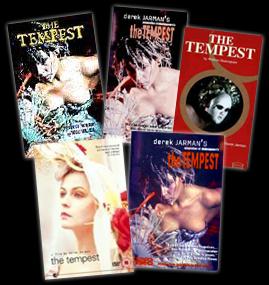 |
The Tempest - Did
You Know? • The
Tempest has been released
several times on VHS over the
years. As well as seperate US,
Japanese, and the recently
released UK DVD versions. On all,
but one, Toyah has been the main
cover star. Sadly, most are now
out of print.
• Toyah
was nominated as BEST NEWCOMER at
the 1980 'Evening Standard Film
Awards' for her role as Miranda.
• This,
despite the fact that this was
her fourth film role, following
Mad in Jubilee, Bessie
Wattie in The Corn Is Green
and Monkey in Quadrophenia.
• Toyah
had a strong dislike of anything
Shakespeare until she was asked
to be part of this production.
• Christopher
Biggins, who plays Stephano in The
Tempest (and also starred
alongside Toyah in the 'Find The
Lady' episode of Shoestring)
had previously appeared in one of
Toyah's favourite films; The
Rocky Horror Picture Show.
|
|